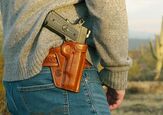AUTOMAG Pistol Design Improvements: The Magazines

During SHOT Show 2018 we reported about the AutoMag Company and the pistol being revived. The company not only recreates the pistol but also makes some design changes that will eventually result in the more reliable latest iteration of the Automag pistol. They started publishing the progress of design changes on their website. In this article, we’ll take a look at the magazine design improvements.
I’ve decided to write this article in a bit thorough manner not only to deliver you the news of the Automag magazine improvements but also to use this chance to talk about the importance of the magazine design in general. It is much better to talk about a subject having a real example which in this case is the AutoMag magazine.
Box magazine looks to be one of the simplest parts of the firearm design. It is basically a metal box with a spring-loaded follower inside it. What can be easier to design? However, as you will see in this article, the geometry of the feed lips, angle and depth of seating, material properties, follower design, spring tension, locking mechanism design – all of these design elements are way more important that one can think of. By misdesigning even one of the mentioned parts, you can easily render an otherwise perfectly functional mechanism into a nightmare of a firearm. And if in the range it will be just annoying and will utmost ruin the day, in a combat or defensive situation these minor design imperfections can cost the shooter his life.
One of the key components of the new AutoMag pistol that is being revised is the magazine. As mentioned above, a good magazine design is crucial to have a reliable firearm. In fact, there are even companies specialized in manufacturing only magazines (e.g. Mec-Gar). Realizing that the original AutoMag magazine leaves a lot to be desired, the company is now designing a new magazine and once a perfectly working prototype is finished they will outsource the production of magazines to one of those specialized vendors. They are changing pretty much everything in the magazine design – feed lip geometry, materials and their hardness, presentation height, lock cutout geometry etc.
One of the problems associated with the early AutoMag magazines was the presentation height of the cartridge. As you can see in the image below, the bolt face in old design has a minimal contact with the cartridge head. Coupled with inconsistent feed lip geometry and the fast, violent cycling of the gun, this design issue was the reason for many malfunctions. The company has redesigned the magazine to seat .100″ higher which results in the bolt having that much more contact with the cartridge case head to ensure a reliable start of feeding.
Next problem with the early magazines was the nosediving. The .44 AutoMag cartridge has a slightly tapered case which results in a tendency of the cartridge stack to form a curve pushing the bullet of top cartridge down. This leads the bullet to push on the base of the feed ramp and cause nose dive malfunctions as shown in the image below.
The company has solved the nose dive issue by redesigning the seating height of the magazine, feed lip and follower geometry. They managed to get a higher seating top cartridge which bullet points up and hits the top of the feed ramp minimizing the possibility of failure-to-feed malfunctions.
Another magazine issue was the improper material used which resulted in too flexible feed lips. The flexible feed lips affected by the violently cycling action could release the top cartridge into the action which would then be jammed by the bolt into the top wall of the chamber. This is like a mirrored version of the nosedive malfunction. AutoMag calls this feeding malfunction “standups”.
Below is another image showing the redesigned magazine catch cutout and the follower.
Compared to the early ’70s, today Auto Mag company has a lot more advanced tools and technologies to make the pistol faster and better. For example, CAD designing and CNC machining alone are a huge aid in making the gun. According to the company, now they are capable of making more parts by machining out of solid steel bars of higher quality. So the magazine is not the only part that will be improved. The company promised to keep publishing information concerning other design changes. We’ll keep our readers posted about the developments around this hand cannon.
These were some of the most important magazine design elements demonstrated on the AutoMag magazine example. What other magazine related issues have you encountered? Share your stories in the comments section.
Images from www.automag.com

Managing Editor Being a lifelong firearms enthusiast, Hrachya always enjoys studying the history and design of guns and ammunition. Should you need to contact him, feel free to shoot him a message at Hrachya@TheFirearmBlog.com
More by Hrachya H

















![[NRAAM 2024] The Glock G17L is Back and it's Optics Ready](https://cdn-fastly.thefirearmblog.com/media/2024/06/04/064426/nraam-2024-the-glock-g17l-is-back-and-it-s-optics-ready.jpg?size=350x220)
![[SHOT 2024] Barak Arms Shows New Removable, Swappable Pistol Grips](https://cdn-fastly.thefirearmblog.com/media/2024/05/19/14783374/shot-2024-barak-arms-shows-new-removable-swappable-pistol-grips.jpg?size=350x220)



![[SHOT 2024] Geissele Automatics Displays New AK Trigger And El Corto SBR](https://cdn-fastly.thefirearmblog.com/media/2024/05/16/14528887/shot-2024-geissele-automatics-displays-new-ak-trigger-and-el-corto-sbr.jpg?size=350x220)







Comments
Join the conversation
Automag - a prime example of the hotrodder's old saw: "If it don't go, chrome it." Purty, ain't she? Yep, but she smells real bad . . .
I would love to have one of these new auto mags,now they have to be able to sell it for less than the desert eagle.